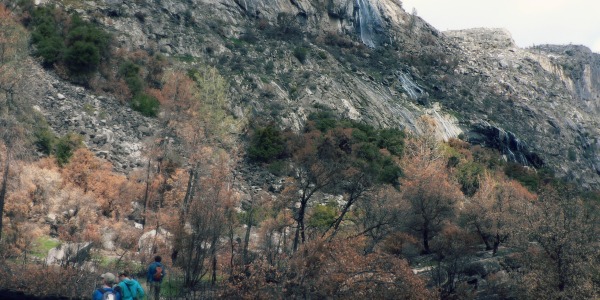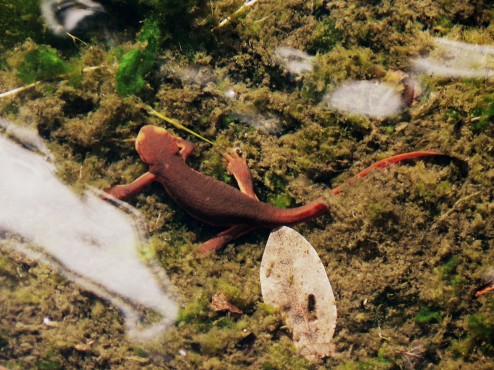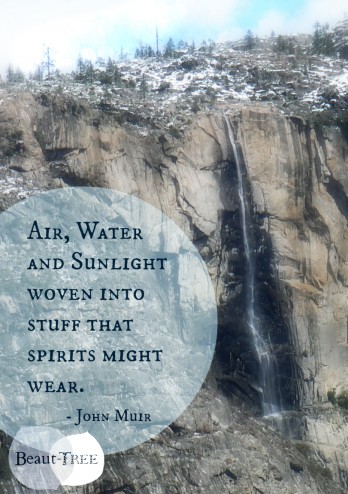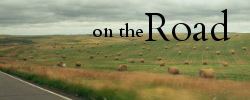
Tueeulala Fall – Hetch Hetchy Valley’s Bridal Veil
Have you heard about the rock slide that happened in the beginning of this month in Hetch Hetchy? It is blocking the trail just past the Wapama Falls footbridges – meaning it shouldn’t affect day hikers too much, unless your game plan was to power hike to Rancheria Falls. Seriously, don’t let this deter you from enjoying Hetch Hetchy’s first two waterfalls, Tueeulala and Wapama falls, this spring.
I was hiking in Hetch Hetchy a few days before the rockslide, at the suggestion of Trails and Wildlife 4-8, doing some Newt reconnaissance. I think we were a bit late for prime newt season (mating season that is), but Hetch Hetchy was beautiful covered in a small amount of snow that had fallen the previous evening, and it was not a wasted trip.

We did see this newt, clinging to some moss, among multiple others. Just not CRAZY amounts of newts. Next time.
We did not actually hike to the base of Tueeulala falls. As the old saying(s) go: Too many newts, Too little time … Mo’ Newts, Mo’ Problems … I got 99 problems, and they all newts. ANYHOW, It would have been a 4-ish mile hike to the base of Tueeulala falls if you are interested (see my previous post on Hetch Hetchy for for information). Instead I enjoyed the newts, and views of the falls available right outside the parking area. Surely this is not what Muir had in mind, but none the less I could not help but think of him.
John Muir, Tuolumne’s Yosemite & Tueeulala Falls
The night prior visiting Hetch Hetchy I had finished reading a version of John Muir’s The Yosemite, making it was fresh in my mind as I looked at the falls. I was not standing in waist high wildflowers as Muir had, but on top of the O’Shaughnessy Dam. A dam built against Muir’s wishes to for a city hundred of miles away, this year holding back an alarming low amount of water.
Muir compares the (then reservoir -less) Hetch Hetchy valley to Yosemite Valley – calling it the Tuolumne’s Yosemite. In fact he makes a number of comparisons, calling Kolana Rock the equivalent of El Capitan, Tueeulala fall the superior to Bridal Veil fall, and Wapama Falls the companion to Yosemite Falls.
Surely Tueeulala Falls must have been running at least one of the half a dozen times I have visited Hetch Hetchy, but I could not clearly recall it. I think it might have been early in my arrival in California, during a wet year and before I realized the transient nature of many of Yosemite’s falls. I had probably been distracted by how large Wapama Falls loomed, choosing to focus less on this other more delicate fall.

Tueeulala Fall
I urge you, if you love waterfalls and have the time, to make the trip to Hetch Hetchy this sping to take a moment to enjoy Tueeulala with this quote from Muir.
Low-landers are apt to suppose that mountain streams in their wild career over cliffs lose control of themselves and tumble in a noisy chaos of mist and spray. On the contrary, on no part of their travels are they more harmonious and self-controlled. Imagine yourself in Hetch Hetchy on a sunny day in June, standing waist-deep in grass and flowers (as I have oftentimes stood), while the great pines sway dreamily with scarce perceptible motion. Looking northward across the Valley you see a plain, gray granite cliff rising abruptly out of the gardens and groves to a height of 1800 feet, and in front of it Tueeulala’s silvery scarf burning with irised sun-fire in every fiber. In the first white outburst of the stream at the head of the fall there is abundance of visible energy, but it is speedily hushed and concealed in divine repose, and its tranquil progress to the base of the cliff is like that of downy feathers in a still room. Now observe the fineness and marvelous distinctness of the various sun-illumined fabrics into which the water is woven; they sift and float from form to form down the face of that grand gray rock in so leisurely and unconfused a manner that you can examine their texture, and patterns and tones of color as you would a piece of embroidery held in the hand. Near the head of the fall you see groups of booming, comet-like masses, their solid, white heads separate, their tails like combed silk interlacing among delicate shadows, ever forming and dissolving, worn out by friction in their rush through the air. Most of these vanish a few hundred feet below the summit, changing to the varied forms of cloud-like drapery. Near the bottom the width of the fall has increased from about twenty-five to a hundred feet. Here it is composed of yet finer tissues, and is still without a trace of disorder — air, water and sunlight woven into stuff that spirits might wear.
Now go forth, and enjoy. More photos from this trip in gallery bellow.



















 Hello! I am a 30-something outdoors-lady, backpacker, and resident of Groveland, California -
Hello! I am a 30-something outdoors-lady, backpacker, and resident of Groveland, California - 


Hi Denise—really enjoy your trip write-ups! FYI, it is “Wapama”, not Wampa. Also the rock ledge below the dam was the old road to Lk. Eleanor when SF was building the dam to create the reservir to gererate power for their massive. project. How ’bout walking between Eleanor and Hetchy on one of you journeys? In places, you can still see some blacktop. Great trip on that old road the entire way, and you can check out Miguel Meadows for a possible sighting of BF. Sincerely, Sharon
Hi Sharon, thanks for the correction! Now if only I can figure out how to pronounce Wapama correctly! I love the tip for the hike between Eleanor and Hetchy, I will for sure be adding that to the to-do list – Along with catching BF ;) – Denise
You will totally enjoy the historic road hike from Eleanor to Hetchy! Btw. say: wah-PAH-ma. In case your might be interested, take a look at one or more of my historical hiking guides. “Trails and Tales of Yosemite and the Central Sierra,” “Exploring Eastern Sierra Canyons: Sonora Pass to Pine Creek,” or “Exploring Eastern Sierra Canyons: Bishop to Lone Pine.”
Cheers, Sharon